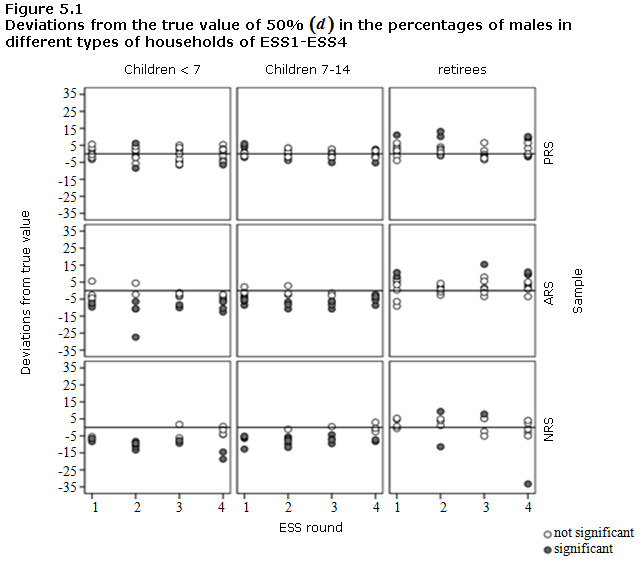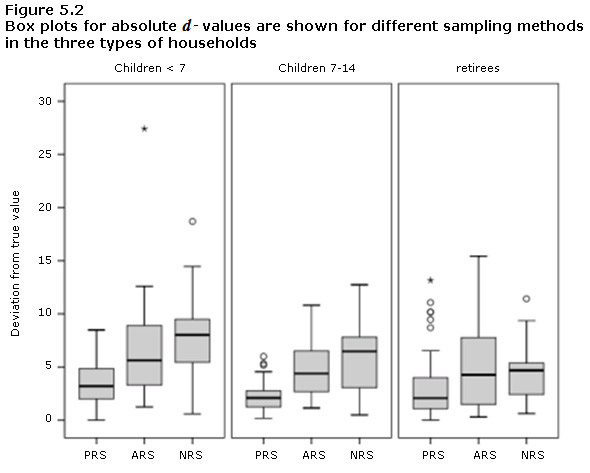5. Results
Natalja Menold
Previous | Next
5.1 Differences between household types
Firstly, the results for testing hypothesis H1
are presented. This hypothesis expects deviations from the 50/50 gender ratio
to vary according to the type of household. Figure 5.1 shows the differences between the actual percentage of
males and the expected true value of 50% in three subsamples. A 95% confidence
interval (CI) was used to control for random fluctuation. As the expected
proportion of men is 0.5, the variance averages whereby is the number of cases in the
subsample in a country. The 95% CI was calculated as follows (cf. Kohler 2007, page 59):
Figure 5.1 shows that for both subsamples
covering households with children, significant values of are negative in the majority of
cases, meaning that the proportion of males in these subsamples is less than
50% (as expected by H1). Most of these -values were
approx. 10% or higher. Lower (approx. 5%) significant positive (unexpected) -values are seen
for three countries in which PRS was used (in the ESS1 in Belgium and Norway,
in the ESS2 in Finland). However, these differences were not discernible in
other rounds.

Description for figure 5.1
Regarding the results for the subsamples
covering households with partners of retirement age (retirees) it is possible
to see significantly high -values (approx.
10% or higher) with the expected direction (positive, or that is to say the
percentages of males are higher than 50%) for some countries across all
sampling methods (in the ESS1 in Norway, the Czech Republic and the
Netherlands; in the ESS 2 in Norway, Poland and France; in the ESS3 in Cyprus
and Russia and in the ESS4 in Germany, Hungary, Cyprus and the United Kingdom).
Interestingly, the proportion of men is markedly lower than 50% in Slovakia in
the ESS4 (as low as approx. 33%) and in Portugal in the ESS2 (as low as approx.
11%). This result can be explained by specific patterns of role division
between the partners. Here the woman appears to represent the household, even
if the man is at home.
To summarise, significant deviations from true
value in different types of households were mainly in line with the
expectations of hypothesis H1.
5.2 Differences between sampling methods
The effect of sampling methods (as expected by
H2) was tested by means of MANCOVA. The -values for the
three types of households (three isolated subsamples) were considered as values
of three dependent variables, which were simultaneously analysed in the
MANCOVA. Since the MANCOVA is based on an
analysis of means the absolute values of
were considered. Otherwise it
would not have been possible to take into account differences with an
unexpected direction, which would also be associated with the effect of
sampling methods. Since most of the differences were negative in the subsamples
with children, the absolute -values represent
a proportion of men that is lower than 50%. With respect to the subsamples with
partners of retirement age, it should be taken into account that the proportion
of men was not only higher than 50% but also lower than 50% in Portugal (ESS2)
and in Slovakia (ESS4). In addition, significant and non-significant
differences are considered in order to enable a comparison between countries
with low and high -values.
The MANCOVA revealed a high significant
multivariate effect of the factor "sampling method" (Wilks Lambda (WL)
effect size
). In contrast,
no significant results for explanatory variables were found (
max
). In order to
consider -values in
different household types univariate analyses of covariance (ANCOVAs) were
employed. Variance homogeneity
as a presupposition for an ANCOVA
is given according to the Levene test in the
subsample with retirees, and also according to the test in the subsamples with children.
Significant mean differences of -values between
sampling methods were found using the ANCOVAs in both subsamples with children
(table 5.1). The variances explained in the ANCOVAs
for these subsamples are quite high (see
in table 5.1).
On average the lowest -value can be
seen for the PRS, while the highest -value is seen
for the NRS (table 5.1 and figure 5.2). However, post-hoc single comparisons using subsamples with children show
significant differences only between PRS and the other two sampling methods
(table 5.2). Also, no remarkable differences in -values were
found between the countries with ALS and with Random Route samples.
Overall, the results show that hypothesis H2
can be partially supported if households with children are considered.
Table 5.1
Descriptive statistics and results of the ANCOVAs for comparison of in the three types of household
Table summary
This table displays the results of Descriptive statistics and results of the ANCOVAs for comparison of in the three types of household types of household (appearing as column headers).
| |
types of household |
| children <7 |
children 7-14 |
retirees |
(countries) |
| Sampling method (treatment) |
|
| PRS |
3.28(2.07) |
2.21(1.37) |
3.34 (3.35) |
43 |
| ARS |
6.61(4.98) |
4.87 (2.74) |
4.94(3.83) |
31 |
| NRS |
7.85 (4.4) |
5.92 (3.55) |
5.78(6.87) |
21 |
|
14.52*** |
20.9*** |
1.93 |
|
| Time: ESS round |
|
| 1 |
4.49(2.67) |
4.08(2.94) |
4.75(3.22) |
22 |
| 2 |
6.92(5.73) |
4.33(3.3) |
3.63(3.71) |
24 |
| 3 |
4.78(3.04) |
4.02(3.18) |
3.74(3.44) |
23 |
| 4 |
5.23(4.41) |
3.24(2.22) |
5.39(6.66) |
26 |
|
0 |
1.18 |
0.02 |
|
| Payment bonus |
|
| no |
5.83(4.37) |
4.41(3.10) |
4.10(3.73) |
54 |
| yes |
4.78(3.99) |
3.23(2.52) |
4.81(5.49) |
41 |
|
0.57 |
3.21+ |
0.49 |
|
| Ratio controlled |
|
|
0.11 |
0.51 |
1.09 |
|
| Ratio confirmed |
|
|
3.11+ |
0.11 |
0 |
|
|
0.22 |
0.31 |
0.01 |
|

Description for figure 5.2
Table 5.2
Mean differences of between sampling methods in subsamples with children
Table summary
This table displays the results of Mean differences of between sampling methods in subsamples with children children <7 and children 7-14 (appearing as column headers).
| |
children <7 |
children 7-14 |
| differences between |
|
| PRS and ARS |
-3.34 (0.89)** |
-2.66 (0.58)** |
| PRS and NRS |
-4.58 (1.0)** |
-3.71 (0.65)** |
| ARS and NRS |
-1.24 (1.07) |
-1.05 (0.7) |
Note ** Single post hoc tests with Bonferroni correction.
5.3 The effect of explanatory variables
The effect of explanatory variables was analysed to test hypothesis H3, which expects deviations from the 50/50 gender ratio to be stable across time and to correlate with payment, interviewer controls and change of data collector.
Some countries in the ESS changed their
sampling method procedures and/or data collector between the rounds (see
appendix). The results showed that neither multivariate effects nor univariate
effects are significant for the change of data collector. Thus, table 5.1
presents the ANCOVA results without this variable. If the "change of data
collector" is included in the analyses, then the effect of the variable "ratio
confirmed" is no longer significant, but this does not impact the effects of
any of the other variables. This result shows that a change of data collectors
may correlate with control procedures. The differences in -values across
the ESS rounds are not significant either, neither within multivariate analysis nor within the univariate
analyses (for the latter see table 5.1).
Table 5.1 shows that in subsamples with
children -value means are
lower if a payment bonus is used as compared to when it is not used. However,
this difference is significant only on a 10% level and only in households with older
children. Hence, this result shows that payment methods may play a role,
thereby reducing deviation from the true value in the case of higher payments.
Regarding control procedures, the number of
controls ("ratio selected") is not related to the value of (table 5.1). The success rate in controls ("ratio confirmed") is related
to the value of in the subsample with children
younger than seven years old. This relationship is negative meaning that the lower the confirmed
control rates are, the higher the values of are. However, this relationship
is also significant only at a 10% level.
Concerning hypothesis H3, it has been shown
that the effect of sampling methods is independent of the time effect. The
results support the expectation of H3 concerning interviewer payment and
controls. However, the results for these variables show that these effects are
only weak and they can only be found in some household types.
Previous | Next

